- Call us: 01444 237070
- Contact Us
- Stores
- Sign In / Register
-
- Back
- Used Cameras
- Used Accessories
- Used Lenses
- Used Video
- Used Film Equipment
- Used Stock Alert
- Used Blank Test
- Sell or Part Exchange
- Used Clearance
- Recently Added Used Equipment
- Park Picks
- All Used Black Friday Deals
- Faulty
- Trade-In
- Blog
- New in
- Call us
- Contact us
- Stores
- Sign in
- Categories
- Tips & Inspiration
- Reviews
- News
- Events
- Features
- Buying Guides
- Competitions
Canon EOS R50 V Camera Review
There has never been a better time for creators who are on the lookout for a Canon vlogging camera. March 2025 saw the launch of an all-new video-first hybrid camera with the Canon EOS R50 V, which comes as body-only or a kit with everything you need to get started on your creative journey with Canon.
Canon EOS R50 V First Look Video Review
The EOS R50 V is the first in a new V for Vlogging segment, which comes packed with technology to help vloggers and creators capture better content that entertains their audience. Our Canon EOS R50 V camera review has everything you need to know to decide whether this is the perfect tool for your vlog content creation.
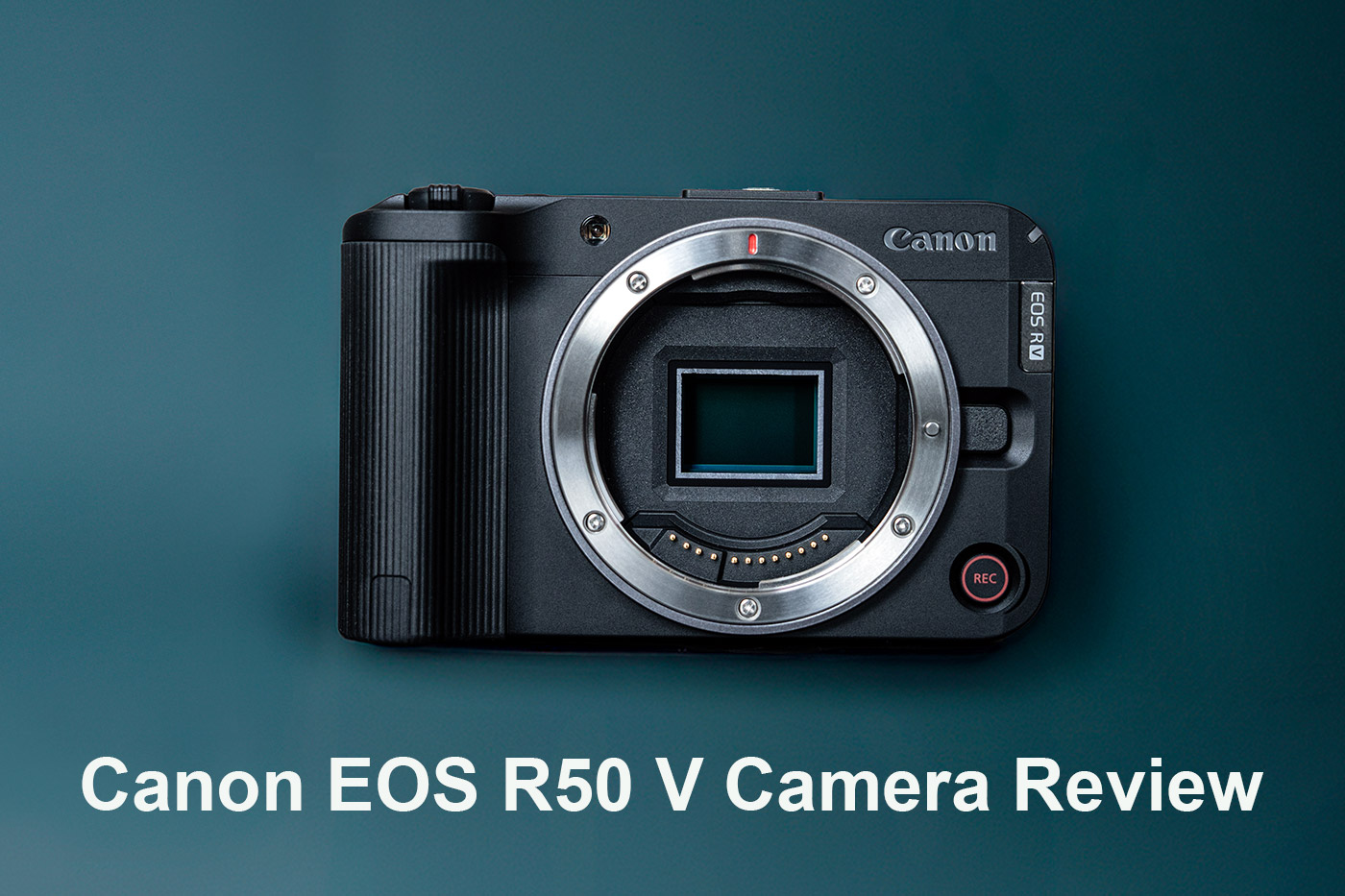
So let’s get stuck in with the first question on everyone’s mind…
How much is the Canon EOS R50 V Camera?
After launching on the 26th of March, 2025, the Canon EOS R50 V camera costs £729.00 for the body-only, £959.00 for the brand new R50 V with RF-S 14-30mm Lens Kit, and the EOS R50 V Content Creator Kit is also available, priced at £999.00. This is excellent value, especially considering the stacked feature set that this new model includes.
By comparison the EOS R50 camera, which launched two years earlier, costs £749.00 for the body-only, and that misses out on a number of the video-first features, which we look at next.

EOS R50 V Key features
As a video-first Canon vlog camera for hybrid content creation, what does the first V series model offer content creators? Features include:
- 24MP APS-C Sensor
- Dual Pixel CMOS AF II
- 4K30p oversampled video from 6K
- 4K shooting for up to two hours
- Vari-angle touchscreen
- Automatic vertical shooting orientation
- Input/Output for a video mic and headphones
- Second tripod hole for vertical shooting in portrait orientation
- Refined grip for handheld shooting
- 4-channel audio and spatial lens support
- 4K streaming over USB
- RF mount to swap out different mirrorless RF lenses
The combination of 24MP APS-C Sensor, Canon’s effective Dual Pixel CMOS AF II autofocus system, and 4K shooting for up to two hours is a great combination for vloggers, but the EOS R 50 V is jam-packed with plenty of other tech for viral-ready clips.

Pro-level video features
On top of everyday tech that makes the job of creating content much simpler, the Canon EOS R 50 V mirrorless camera adds advanced capabilities for making pro-level content more easily. These include:
- High-speed 4K 60p (cropped) or Full HD 120p in-camera
- A Custom Picture profile for consistent styles
- Aspect markers, Timecode and assist tools like false colour, zebra display, and MF peaking
- A tally lamp
- Canon’s advanced hot shoe for cable-free accessories like a microphone
These allow creators to step up to the next level, while making everyday content easy to produce.
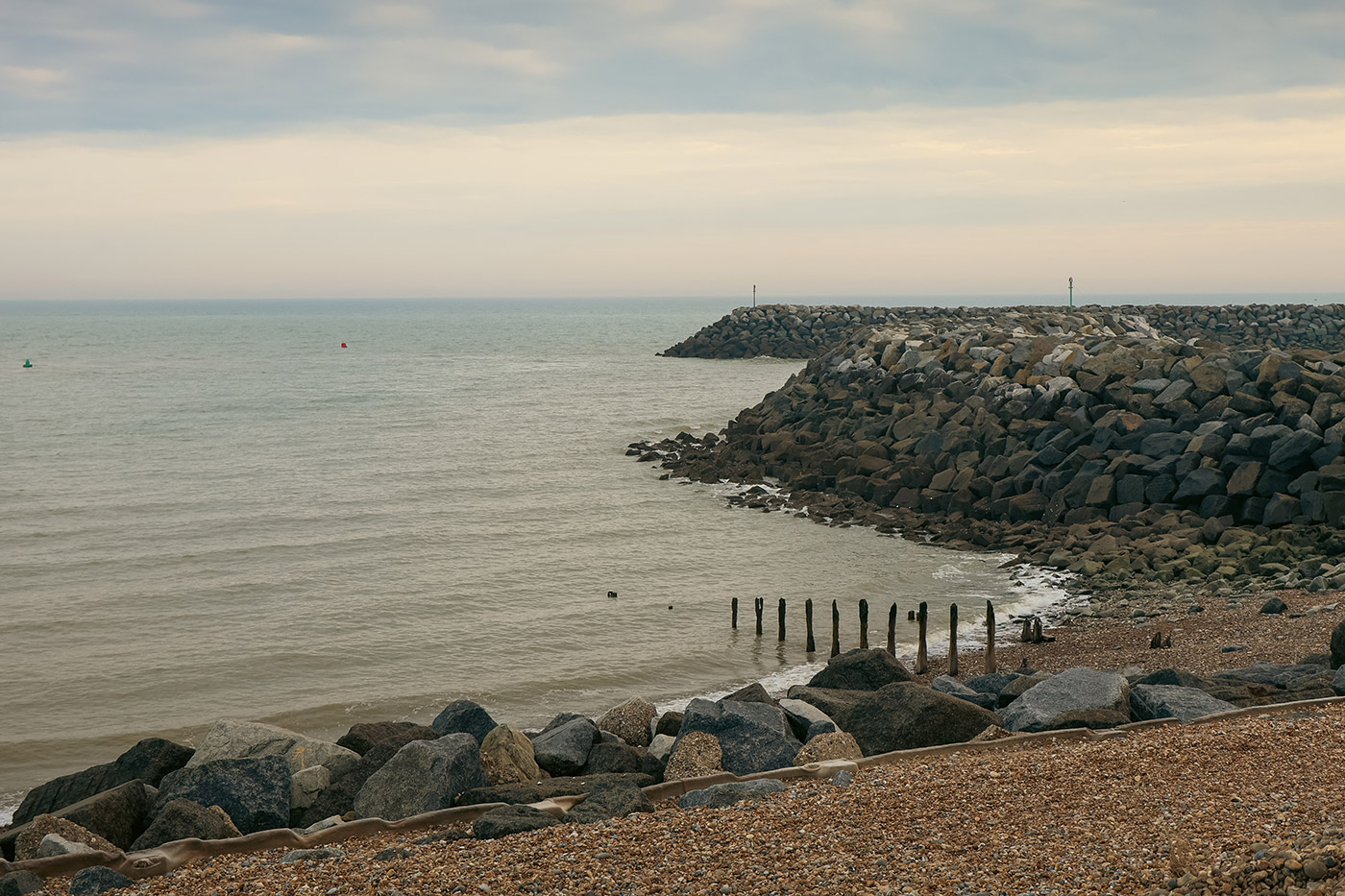
Sample EOS R50 V with RF-S 14-30mm lens at 30mm. Camera settings 1/125 sec. f/6.3. ISO 160
What is Dual Pixel CMOS AF II?
Canon’s Dual Pixel CMOS AF II is an advanced autofocus system developed for their mirrorless camera lineup. Now in its second generation, it uses a dual-pixel design combined with EOS iTR AF X subject detection and tracking. This system incorporates deep learning technology to recognise and track subjects as they move across the frame.
This autofocus system is fast, accurate, and reliable, and has been implemented across Canon’s range, from beginner-friendly models to professional cameras. It can track people, certain animals, and vehicles with greater accuracy, using a wider area of the APS-C sensor than was previously possible with DSLRs or earlier autofocus systems.
By handling focus automatically, Dual Pixel CMOS AF II lets creators concentrate on framing, presenting, and directing, rather than worrying about keeping themselves or their subjects in sharp focus.
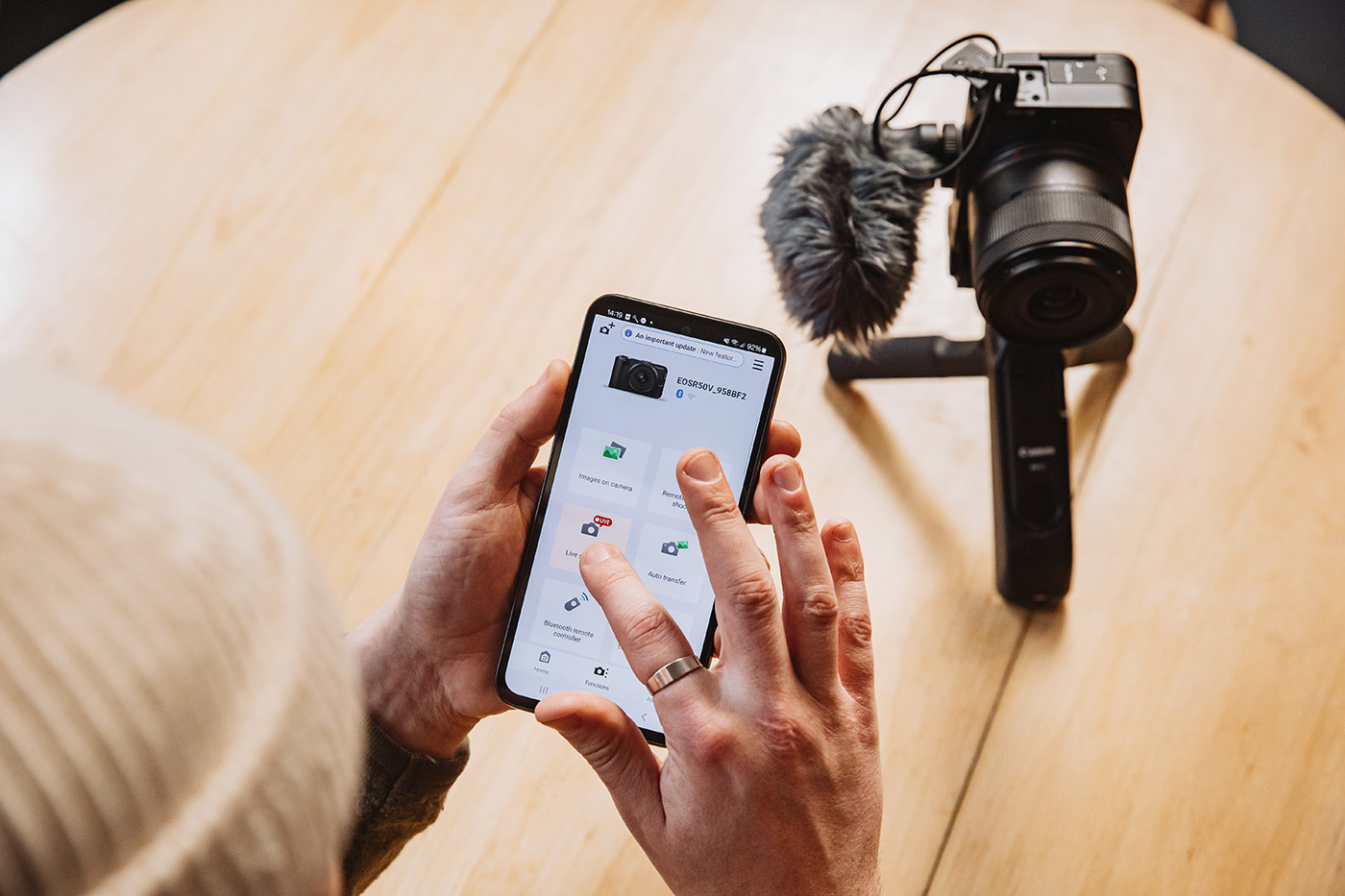
How is the handling and ergonomics?
Canon has slightly redesigned the EOS R50 V body compared to previous models. This generation features a more comfortable grip for handheld use, which is particularly important for run-and-gun content creation, where tripods and gimbals aren’t always an option, especially during longer recording sessions.
The updated Vari-angle touchscreen has been developed to make vertical content creation easier too. It now works alongside a second tripod socket, allowing for unobstructed recording when filming in portrait orientation. The LCD screen no longer interferes with cables or connectors in either horizontal or vertical, and Canon’s updated UI automatically flips menus and icons when switching to vertical mode.
Other useful handling features include a red record button on the front of the camera for quick and easy activation while vlogging, and a tally lamp that lets you know when the camera is rolling, helping you stay aware at all times.
There’s also a power zoom lever, which enables smooth zooming with a PZ lens using the built-in control rather than manually rotating the lens ring. This is particularly useful for vlogging with the Canon RF-S 14-30mm f/4-6.3 IS STM PZ Lens, which is included in a kit.
The Canon EOS R50 V has been refined for convenient vlogging, handheld recording, and photography, with tools that enhance your control and shooting comfort.
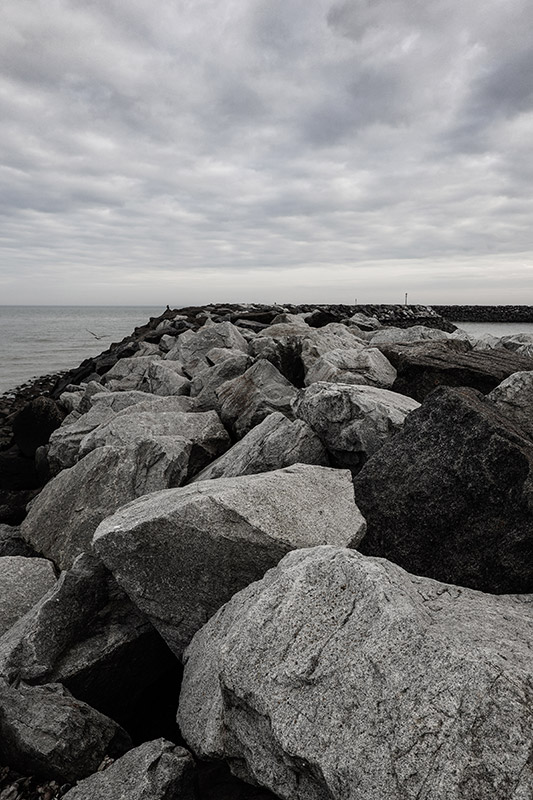
Sample EOS R50 V with RF-S 14-30mm lens at 14mm. Camera settings 1/125 sec. f/5.6. ISO 100
Who is the EOS R 50 V for?
The Canon EOS R50 V has the potential to accompany vloggers and content creators at every stage of their journey. Whether you’re a beginner just starting your first channel, a seasoned travel creator, or an experienced content producer who generates income through their videos.
Unlike compact all-in-one cameras such as the Canon PowerShot V1, which launched at the same time, the EOS R50 V features Canon’s RF mount. This allows users to swap lenses depending on their content style, making it more versatile for creators who want to experiment with different focal lengths.
For beginners, the intuitive vari-angle touchscreen, subject tracking autofocus, and easy-to-use menus make vlogging more straightforward, while the built-in tally lamp, dual tripod sockets, and power zoom controls help everyone capture content more easily.
For experienced creators, 4K recording up to two hours, Canon Log 3, and pro-level assist tools allow for a high-quality production workflows, whether recording content for YouTube, personal projects, or for live streaming.
If you’re deciding between the EOS R50 V and the PowerShot V1, check out our Canon PowerShot V1 First Look Review for a closer look at Canon’s compact, point-and-shoot camera.

RF Lens versatility
One of the advantages of the Canon EOS R50 V is its RF mount, which gives content creators access to a growing range of crop format RF-S lenses, which are for APS-C cameras. This opens up a wealth of possibilities for vlogging, video, and social media content, with compact, lightweight models for handheld shooting.
The Canon RF-S 14-30mm f/4-6.3 IS STM PZ Lens is a new option, which includes power zoom (PZ) functionality, and is aimed at video-first creators. With smooth zoom transitions controlled from the camera body or compatible gimbals, it provides professional-looking footage without abrupt focal shifts or fingers in front of the lens when recording selfies. The ultra-wide 14mm focal length is perfect for handheld vlogging at arms-length, capturing enough of the background, while keeping you focused in frame.
Third-party manufacturers like Sigma have also released options the RF-S format, and Sigma has six RF-S lenses that expand the lineup significantly. The Sigma 10-18mm F2.8 DC DN Contemporary Lens is an alternative wide angle lens adept for low-light shooting, which makes another great choice for vloggers who benefit from the bright f/2.8 aperture.
This is a great time to join the RF mount ecosystem with new lenses appearing not only from Canon, but also third party manufacturers.
Specs comparison EOS R50 V vs PowerShot V1 Vs Original R50
To help you decide which fits your creative workflow best, this specs comparison table breaks down key differences between three of Canon’s most accessible video-first camera for vlogging and content creation.
|
|
|||
|
Sensor |
Approx. 22.3 x 14.9 mm (APS-C) CMOS |
1.4-inch (18.4 x 12.3 mm) CMOS |
Approx. 22.3 x14.9 mm (APS-C) CMOS |
|
Resolution |
24.2MP |
22.3MP |
24.2MP |
|
Image Processor |
DIGIC X |
DIGIC X |
DIGIC X |
|
Lens |
Interchangeable RF/RF-S mount lenses |
Fixed 8.2-25.6 mm f/2.8-4.5 (16-50 mm equivalent) |
Interchangeable RF/RF-S mount lenses |
|
Native ISO Range |
100-32,000 |
100-32,000 |
100-32,000 |
|
Autofocus System |
Dual Pixel CMOS AF II |
Dual Pixel CMOS AF |
Dual Pixel CMOS AF II |
|
Subject Detection |
Eye/Face Detection and Tracking AF (people, animals and vehicles) |
People, animals vehicles |
People, animals vehicles |
|
Image Stabilisation (IBIS) |
Lens / Digital only |
Optical stabilisation; electronic vibration reduction |
Lens / Digital only |
|
Continuous Shooting |
Up to 15 fps with electronic shutter |
Up to 15 fps with mechanical shutter; up to 30 fps with electronic shutter |
Up to 15 fps with electronic shutter |
|
Video Recording |
4K UHD up to 30p (6K oversampled), Full HD up to 120p |
4K UHD up to 60p (cropped), 4K UHD up to 30p (full sensor width), Full HD up to 120p |
4K UHD up to 30p (6K oversampled), Full HD up to 120p |
|
Max Video Quality |
4K UHD at 30p |
4K UHD at 60p (cropped) |
4K UHD at 30p |
|
Max Image Size |
6000 x 4000 pixels |
5760 x 3840 pixels |
6000 x 4000 pixels |
|
Viewfinder |
N/A |
N/A |
0.39-inch OLED EVF, 2.36 million dots |
|
LCD Screen |
3-inch vari-angle touchscreen, 1.04 million dots |
3-inch vari-angle touchscreen, 1.04 million dots |
3-inch vari-angle touchscreen, 1.62 million dots |
|
Storage Media |
SD/SDHC/SDXC (UHS-II) |
SD/SDHC/SDXC (UHS-II) |
SD/SDHC/SDXC (UHS-I) |
|
Battery |
|||
|
Max. Battery Life for Still Images |
TBC |
Approx. 400 shots |
Approx. 370 shots |
|
Dimensions (WxHxD) |
Approx. 119.3 x 73.7 x 45.2 mm |
Approx. 118.3 x 68.0 x 52.5 mm |
Approx. 116.3 x 85.5 x 68.8 mm |
|
Weight (Approx) |
375 g |
426g |
375g |
|
Connectivity |
Wi-Fi, Bluetooth, USB-C, HDMI, microphone and headphone jacks |
Wi-Fi, Bluetooth, USB-C, HDMI, microphone and headphone jacks |
Wi-Fi, Bluetooth, USB-C, HDMI, microphone and headphone jacks |
|
Price |
£729.00 (body-only) |
£959.00 |
£749.00 (body-only) |
Best accessories for the Canon EOS R50 V
Adding an RF mount lens and a few well-chosen accessories can make shooting easier and elevate your shooting experience and overall quality with the Canon EOS R50 V.
For handheld vlogging, the Canon Tripod Grip HG-100TBR is a great option. It gives you a solid grip when recording on the move and quickly converts into a tripod for static shots. The built-in Bluetooth remote lets you start and stop recording without touching the camera, which is useful for self-shooting and hands-free setups.
Audio makes a huge difference in video quality, and an external microphone is a smart upgrade. The Rode VideoMic GO II cuts out background noise for clearer sound, especially when filming outdoors. If you want to stick within the canon ecosystem you can opt for the Canon Stereo Microphone DM-E100, which will significantly improve audio quality.
For low-light shooting, a Canon Speedlite connects via the advanced hot shoe, giving you better lighting control for events, portraits, or studio work. With the right setup, the EOS R50 V handles everything from quick vlogs to polished video projects, whether you’re filming handheld, on a tripod, or with professional sound.
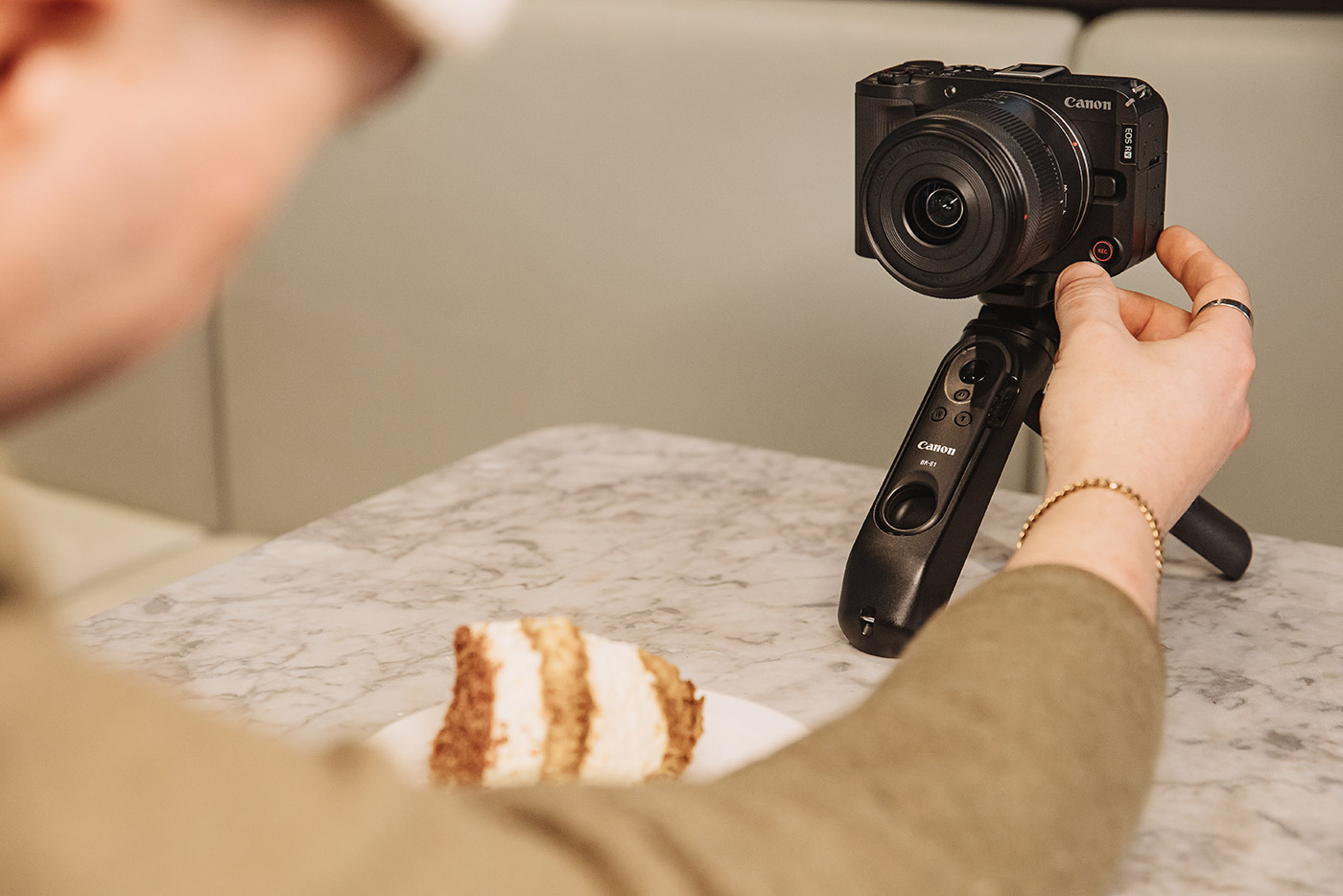
RF Mount Lenses and the new RF-S 14-30mm f/4-6.3 IS STM PZ Lens
Canon’s RF mount supports an expanding range of lenses for every type of content creation, from ultra-wide zooms and compact primes to macro and portrait options. Third-party manufacturers including Sigma, Viltrox and Tamron have released compatible RF-S lenses, offering affordable alternatives across a range of focal lengths. This growing choice helps creators tailor their setups for YouTube, social media or professional commercial work.
The Canon RF-S 14-30mm f/4-6.3 IS STM PZ is a power zoom lens for content creators who want smooth, stable results with Canon APS-C mirrorless cameras. It covers a 22–48mm full-frame equivalent range, which is perfect for vlogging, live-streaming, and general handheld shooting.
The internal zoom mechanism keeps the lens compact and perfectly balanced, even on gimbals or tripods. Canon’s stepping motor (STM) delivers silent autofocus for video, while the power zoom enables remote or camera-based control with supported models like the EOS R50 V. The lens is included in a Canon EOS R50 V Camera with RF-S 14-30mm Lens Kit, as well as with the EOS R50 V Creator Kit, which includes additional accessories to get you started.
The Canon EOS R50 V is a very capable, video-first mirrorless camera that makes content creation easier, more accessible, and more professional for today’s generation of creators. From the hi-res 24MP APS-C sensor to Canon’s excellent Dual Pixel CMOS AF II autofocus system, the R50 V delivers what you need to produce sharp, high-quality video and stills. With its redesigned grip, new tally lamp, vertical shooting support, and enhanced ergonomics, it’s built for life in front of and behind the lens.

Whether you’re starting your YouTube channel, upgrading from a smartphone, or expanding your content kit, the Canon EOS R50 V is an great choice. You can buy the Canon EOS R50 V Camera Body only, opt for the EOS R50 V Camera with RF-S 14-30mm Lens Kit, or go all-in with the Canon EOS R50 V Creator Kit to get everything you need to start producing high-quality content from day one. Whichever you choose, share your images with us, we’d love to see what you create
If you’re upgrading, why not get a fast, free trade-in quotation? We take the hassle out of selling your old camera equipment with our convenient trade-in process.
Share this post:
By Nick Dautlich on 26/03/2025
Nick Dautlich
Senior Content Writer and Product Reviewer
Nick Dautlich is the Senior Content Writer and Product Reviewer at Park Cameras, with over 15 years of photography experience. A Sony Imaging Professional and expert reviewer, Nick has worked with major brands such as Canon, Sony and Nikon. His work is also featured on Vanguard World UK’s website, Capture Landscapes, and Shutter Evolve. Nick’s photography includes National Trust projects and magazine covers and he is passionate about landscapes and storytelling. Nick also enjoys hiking and teaching his children about nature. Learn more on his profile page.
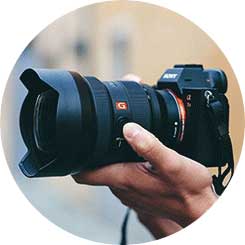
Trade in your old equipment
Fast and easy trade in service ensures your old gear is collected efficiently and you are paid quickly! It's very simple to trade in your unwanted photography gear. Just head over to our dedicated Sell or Part Exchange page, fill out the details, and we'll get back to you with an offer for your old gear. Take the cash, or put it towards the cost of your new gear. It's up to you! Find out more
sign up to the newsletter
Keep up to date on the latest photography news, events and offers. Sign up now
